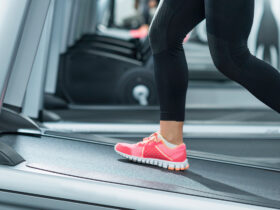Women’s running shoes are being redesigned to better support them.
Modern performance shoes have been worn by women for as long as they have been running—After women like Bobbi Gibbs and Kathrine Switzer destroyed the myth that running more than one or two miles would destroy a woman’s uterus in the late 1960s—These sneakers are made for the feet of men.
Having men as athletes and designers dominated the sport made sense. RunRepeat.com published The State of Running report in 2019 that In the study, more women ran than men-58 percent-were running in the United States in 2019. Data from The NPD Group Inc. found women’s running shoes sales increased more rapidly than men’s in 2021, primarily driven by running.
Female athletes no longer want to sacrifice their footwear due to the increasing number of women on the roads, trails, and tracks, Shoe designs are based on the anatomy of another gender’s feet, then altered to fit the feet of the current gender. Women’s running shoes are finally becoming a priority for shoe companies as more and more female designers join the top companies in the world.
There are differences between the feet of men and women
Lasts are foot-shaped molds that determine the fit, the feel, and the proportions of shoes. For a long time, only molds of men’s feet were used to make lasts. According to a 2009 study in the Journal of the American Podiatric Medical Association, female feet are not algebraically scaled, smaller versions of male feet.
In response, women’s lasts were developed based on a woman’s foot mold.
Unisex lasts have also been made available, for whatever it’s worth—Sheeluxe Footwear’s Research Operations Supervisor, Katie Manser, takes an independent shoe research lab, dismisses. In anatomical terms, a woman’s foot is different from a man’s foot.
Shoe designers historically haven’t paid much attention to different foot sizes.
To begin with, “Because women’s weight is naturally distributed toward the front of their bodies, they have wider forefoot and narrower heel than men.” According to OESH Shoes founder Casey Kerrigan, MD, Footwear brand for women.
Foot shapes differ between men and women, which are more triangular in shape.
According to Manser, if women don’t take their time when trying on shoes, their forefeet will be 70 percent tighter, while the heels will be 30 percent looser. “Mortons neuromas, bunions, metatarsalgia, all of those problems can be attributed to that,” says Kerrigan. Your knees and hips will also be affected, as well.
Furthermore, a wide heel that is unstable “ prevents women from absorbing and utilizing impact,” says Kerrigan. It is in your body’s nature to absorb force when it strikes the ground, then use it to propel you forward; when you don’t have the security at the heel, you’ll have a hard time pushing off in your gait.
“In addition, women have a higher peak eversion during running by five and a half degrees, Overpronation is the same motion.” says Manser. Running with overpronation causes the foot arch to roll inward,You are more likely to suffer an injury if you are exposed to increased ground reaction forces.
The lighter women are, according to Manser, the less fat they have to carry around. During foot-strikes, they feel less impact—Their mass does not allow them to compress foam, so they need a softer landing.
“A woman’s heel to forefoot drop is usually higher than a man’s, Therefore, more cushioning in the heel might be better from a comfort perspective,” says Manser.
Women’s gaits differ from men’s in these minor ways. In shoes that aren’t made for your foot, over a period of eight minutes, you make 1,400 steps, which adds up. The amount of options you have when it comes to movement patterns is limited if your shoes don’t fit right or feel uncomfortable. Injuries caused by overuse can be avoided by repetitive motions that are not right for your body.
There is a higher risk of injury for women runners than for men, The journal Physical Activity and Health published a scientific review in 2021 that found; Runner’s knee (also known as patellofemoral pain syndrome) is one of them.
Sacroiliac and iliotibial band syndromes, British Journal of Sports Medicine published older research on this topic. Furthermore, bone stress injuries were more likely to occur in them. The Sports Medicine review published in 2021 noted—Lack of support at the feet is certainly responsible for this problem.Is there a point to all of this? There is more to it than just using a women’s foot-shaped last, In order to maximize women’s running potential, women’s running shoes need to address physiological and biochemical distinctions.
Running shoes for women: a new breed
The “shrink it and pink it” approach to women’s running shoes needs to be abandoned if fit and feel are the main problems women’s feet face.
Considering its previous focus on activewear, Lululemon might seem unlikely to be a groundbreaker here, but in recent years it has become an internationally recognized brand—In addition to sponsoring several track and field teams, it launched a Global Run collection and Olympians Colleen Quigley and Nikki Hiltz compete in the 1500 meters—Shoes are being designed with the same feel-first philosophy that governs apparel.
According to George Robusti, vice president of footwear design at Lululemon, the company intentionally launched footwear with a women’s running sneaker. We wanted any shoe we designed to be an elevated experience and sensation because the foot has so many sensory receptors.”
Blissfeel, which debuted in March, shows the results. “From two miles per week to 40 miles over four hours, it’s a cushioned, neutral shoe that does it all.,” says Robusti. Using soft blown rubber in the forefoot and a stronger rubber in the heel, the midsole is a single layer of thick foam. Its molded heel collar and breathable upper make it a great choice for all year long.It’s uncluttered, without distractions or bells and whistles. “”Every runner can enjoy a run, regardless of the length or speed, thanks to the shoe’s inclusiveness and democratic nature.”” says Robusti.
Women’s UA Flow Synchronicity shoes were also developed by Under Armour on June 1— created by starting inside out. “Women’s feet and their experiences in shoes were a big consideration for us. In addition, I wanted something that felt like her foot was an extension of it, and is in sync with her natural movement,” says Katie Lau. In her position at Under Armour, she directs the sportstyle footwear department.
Based on findings from 3D scans, A new last developed by the brand contours to the heel of a woman, following customized lab testing and fit and wear tests,
With a smaller circumference in the instep region and a shallower toe area, it fits the female arch well,” says Lau.“ Compared to men, women are more aware of sensations,” she adds. “We’re customizing the shoe for her with these features, and it’s all part of enhancing the running experience.”
Flow midsole with responsiveness is found in the Synchronicity. Another running shoe from Under Armour has long-lasting cushioning. The outsole geometry is also rounded to provide a smooth landing as well as transitions. With zones for security or flexibility, this upper is minimalist and flexible. According to Lau, the heel is locked down by a midfoot “wing” overlay.
“Women also have a more centered gait cycle than men, whereas men tend to point their toes outward during gait,” she says.
In addition to providing a more cushioned landing, the Ultraboost 22 also supports the medial side of the foot, Rubber is baked into the outsole to prevent overpronation thanks to a small, slightly thicker piece.
Do You Understand What This Means?
A new product on the shelf isn’t the only goal of these innovations—Their willingness to learn more about the female body can be seen as an indication of an increase in understanding.
In scientific research, women have been underrepresented for too long because of the gender gap, Research on products and clinical trials.
However, women are not small men, so solutions that work for men may not work for them.
“Men have been the focus of most performance shoe research,” says Healey. “Women still need to be educated in many areas. We’re finally starting to dive into that, and I think that’s great.”
There’s no claiming that these shoes are the best, Lau argues that the most insightful firms are not necessarily the most competitive ones.
“Our goal is to empower women by giving them choice,” she explains. “Women have the right to make their own decisions through choice, ‘Which model works best for me, gender inclusive or not?,
Or do I want a model that is geared towards women?’
Option A will still appeal to some women, and Option B may appeal to some people. However, we wanted to let the woman make that decision.”





